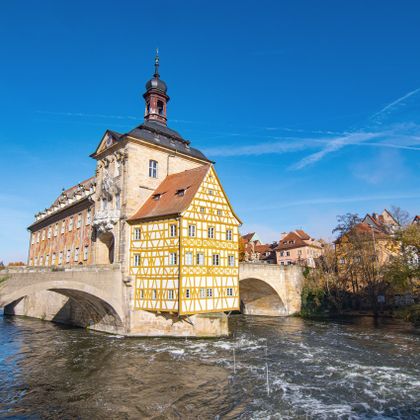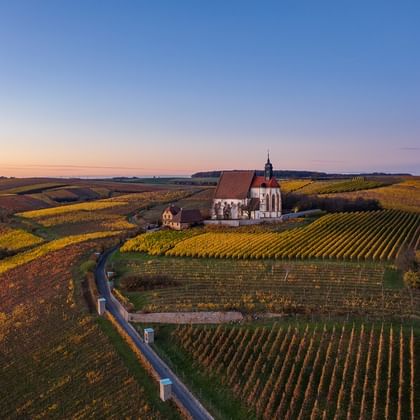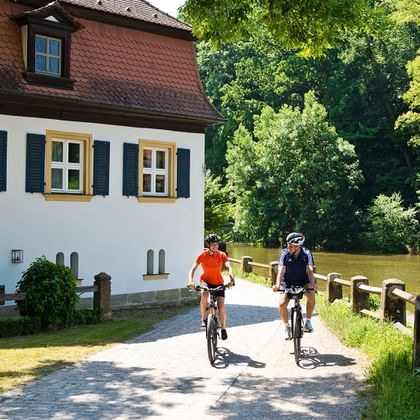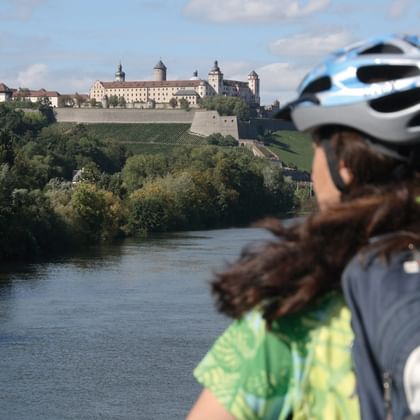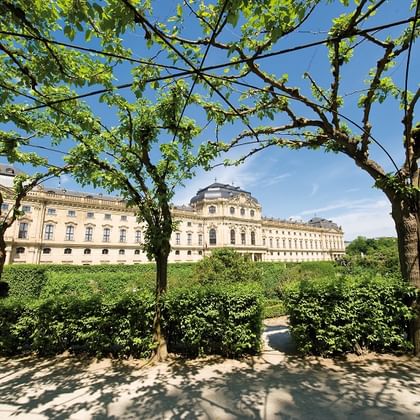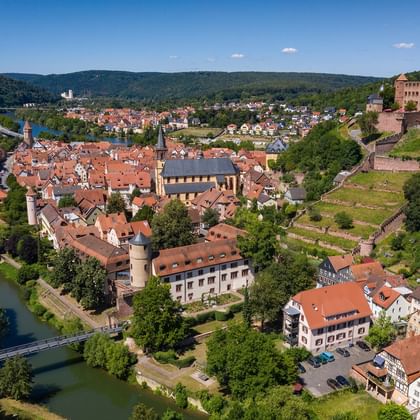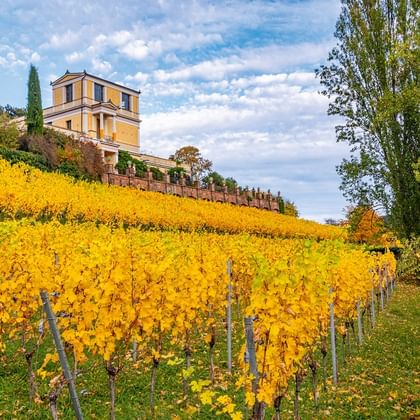Tour
Once you've arrived, take the time to discover the old city, with its breweries and churches. We recommend seeing the Kaiserdom with its world-famous sculptures, such as the Bamberg knight and Heinrich II's sarcophagus.
Follow the Regnitz for a short moment until you reach the Main River, taking you now to the beautiful pilgrimage church Maria Limbach. You will soon reach the first vineyards marking the border between the beer-brewing and the wine-growing areas of Franconia. Enjoy a sunny day in Haßfurt where another historical Old-town will impress you. A short side-trip to Theres is recommendable today: After a nice break there, you will continue along the edge of the Main to Schweinfurt. Discover the vestiges of the ancient imperial town and walk on the footprints of the industrial pioneers and discoverers and let the modern Schweinfurt treat you!
Passing numerous vineyards, you will cycle through the small, historic wine-growing town Wipfeld, home of the "Zehntgraf". Take a relaxing break here and marvel at the precious old buildings of the town and its idyllic situation. In the afternoon, you will cross Fahr, town of the Bocksbeutel (the local wine is sold in this unique kind of container), to reach Volkach, famous for its excellent wines!
After leaving Volkach you'll head away from the Main for a bit, following canals until you make it back to the Main in Schwarzach. The level, well-paved bike route means you'll be in Würzburg in no time, leaving plenty of opportunities to tour the city in the afternoon.
On your way to Karlstadt and its famous downtown area, you'll pass through Veitshöchheim, getting a chance to see the bishop's summer residence, as well as the French rococo garden. The look of the countryside is changing: instead of the characteristic vines there are shady forests directly at the bicycle path. On flat paths you cycle to Gemünden, the town of the three rivers. Take a break here to visit the old castle before you leave to your today's overnight stay in Lohr.
The Main took millions of years to carve out the close-packed hills of the area. Thankfully, your trip will not take that long. After you pass Rothenfels, whose castle guards the narrow valley, you'll reach Marktheidenfeld and, finally, Wertheim. Take some time to see the beautiful half-timbered houses in the old city during your stay here.
In the morning you should pedal hard in order to be in Miltenberg at noon. In Miltenberg you can see many stately half-timbered houses.
Today you cycle on flat paths quickly between the rises of the Spessart and the forest Odenwald to the sandstone palace Johannisburg in Aschaffenburg.
After breakfast your nice cycle holiday ends in Aschaffenburg. We recommend our transfer service back to Bamberg (each Wednesday, Saturday and Sunday, departure 9 am, duration about 3 hrs.)
Map
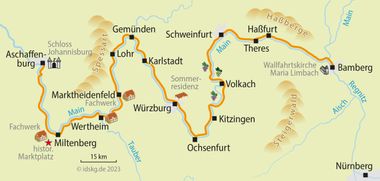
Prices/Dates
Services / Info
- Accommodation incl. breakfast:
Category A: Comfortable middle-class hotels, mostly in the center
Category B: partly family-run inns and smaller hotels - Room with shower/bath/WC
- Luggage transport
- Map of bike trails with marked route
- Digital route guidance via smartphone app for almost all journeys
- Tips for tour preparation
- Touristic information
- 7 days hotline service
Worth knowing about the bike tour Main: Bamberg - Aschaffenburg
Below you will find specific information about the Rhine Winery tour. If you have further questions about this trip, you simply call us: Phone: 06421 – 886890.
Arrival by train
Bamberg is easy to reach by train from all major cities in Germany. The best way to reach our partner hotels from the train station is by taking a short cab ride. You can find up-to-date timetable information and prices at www.bahn.de.
Parking facilities at the arrival location
There is usually no parking available at our contracted hotels in Bamberg city center. Here you can park in public parking garages from €8.00 per day.
You will receive detailed information on parking facilities at the hotel you have booked with your detailed travel documents two weeks before the start of your trip
Condition of cycle paths
The Main Cycle Route was the first cycle route in Germany to be awarded five stars by the ADFC in 2008. Important criteria for this award were the almost continuous asphalt surface and the almost car-free route. The cycle path is signposted throughout, runs mostly along the banks of the Main and has no gradients worth mentioning.
Extra costs which are not included in the tour price
Any tourist tax and charging fees for bicycle batteries are not included in the tour price and must therefore be paid at the hotel.
7 day hotline service
Just in case the bike chain breaks, flooding makes it impossible to continue your tour or any other nasty surprise: You can reach us seven days a week and we will do anything to help you as fast as possible.
Passport and visa requirements
For EU citizens, there are no special passport or visa requirements and no health formalities to be considered for this trip.
Travel insurance
The tour price already includes the statutory insolvency insurance. In addition, we recommend that you take out travel cancellation insurance upon receipt of your travel confirmation in order to protect yourself against financial disadvantages in the event of travel cancellation, interruption of travel, illness or accident.
For all those who want to combine comfort with sustainability and only require digital travel documents, we grant a discount of € 20.00 per room.
Please let us know at the time of booking whether you would like to use printed or digital travel documents.
Available rental bikes
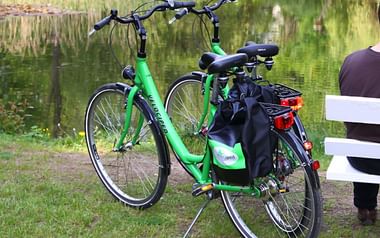
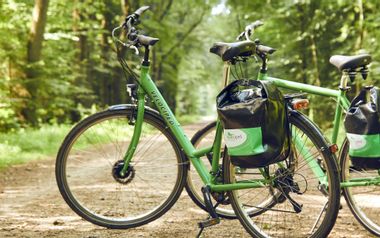
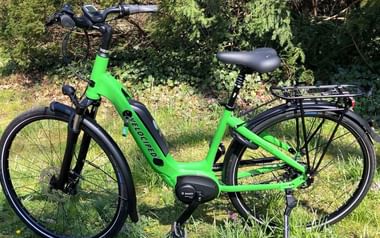


We would recommend the 7-speed tourer for all those that are looking for a back-pedal brake and wide gel seat for maximum comfort in an upright sitting position. It is equipped with a simple hub gear shift and is perfectly suited to tours on flat to slightly hilly terrain.

The 27-speed tourer is the best choice for cyclists that value the advantages of the dérailleur gear shift for flexibility whilst going up and down hills. This bike allows you to be a little more active without compromising on saddle comfort and practical everyday suitability.

E-bikes combine a lot of advantages. The electric drive ensures a completely relaxed cycling, even during long tours or on hilly routes. Other features, such as a suspension seat post and front fork plus well-tuned gears, ensure additional riding comfort.

On this trip, you can choose between e-bikes with a back-pedal brake or a freewheel. The e-bikes with a freewheel also offer you excellent riding comfort with a suspension seat post and front fork. Please simply indicate your preference when booking.

I provide you with advice and assistance
Miriam Houda
